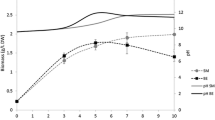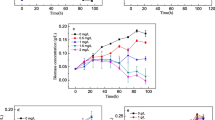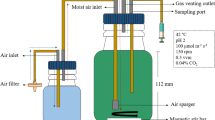Abstract
Maximum protein accumulation (71%, w/w) and nutrient removal by a mutant strain of Spirulina maxima growing on sea water supplemented with anaerobically treated pig slurry was achieved at 30°C with constant illumination (60 to 70 μEm-2s-1), using a flow rate of 14.5 cm s-1 (20 rev. min-1 of a paddle wheel). Total phosphates were decreased by 99% and all ammonia-N was removed under these conditions.
Similar content being viewed by others
References
American Public Health Association 1975 Standard Methods for the Examination of Water and Wastewater, 14th ed. Washington DC: APHA.
GiferriO. 1983 Spirulina, the edible microorganism. Microbiological Reviews 47, 551–578.
FaucherO., CoupalB. & LeduyA. 1979 Utilization of seawater-urea as a culture medium for Spirulina maxima. Canadian Journal of Microbiology 25, 752–759.
HerbertD., PhippsP.J. & StrangeR. E. 1971 Chemical analysis of microbial cells. Methods in Microbiology 5B, 209–344.
MaterassiR., TrediciM. & BalloniW. 1984 Spirulina culture in sea-water. Journal of Applied Microbiology and Biotechnology 19, 384–386.
OlguínE.J. 1982 Conversion of animal waste into algae protein within an integrated agriculture system. In Proceedings of the Seminar on Microbiological Conversion of Raw Materials and By-Products of Agriculture into Protein, Alcohol and Other Products. Novi Sad, Serbia: Novi Sad University Press, pp. 203–218.
Olguín, E.J., Camacho, R., Gonzalez, R. & Mercado, G. 1992 Spirulina cultivation in sea water supplemented with anaerobic effluents. In Proceedings of the Ninth International Biotechnology Symposium, Crystal City, Va., abstract 310.
TrediciM.R., PapuzzoT. & TomaselliL. 1986 Outdoor mass culture of Spirulina maxima in sea-water. Journal of Applied Microbiology and Biotechnology 24, 47–50.
VonshakA. & GuyR. 1992 Photoadaptation, photoinhibition and productivity in the blue green algae, Spirulina platensis grown outdoors. Plant, Cell and Environment 15, 613–616.
Zarrouk, C. 1966 Contribution a l'etude d'une Cyanophycee. Influence de divers facteurs physiques et chimiques sur la croissance et la photosynthese de Spirulina maxima. PhD. Thesis. University of Paris, France.
Additional information
The authors are with the Department of Environmental Biotechnology, Institute of Ecology, Aptd Postal 63, Xalapa, Ver., Mexico
Rights and permissions
About this article
Cite this article
Olguín, E.J., Hernández, B., Araus, A. et al. Simultaneous high-biomass protein production and nutrient removal using Spirulina maxima in sea water supplemented with anaerobic effluents. World J Microbiol Biotechnol 10, 576–578 (1994). https://doi.org/10.1007/BF00367671
Revised:
Accepted:
Published:
Issue Date:
DOI: https://doi.org/10.1007/BF00367671




